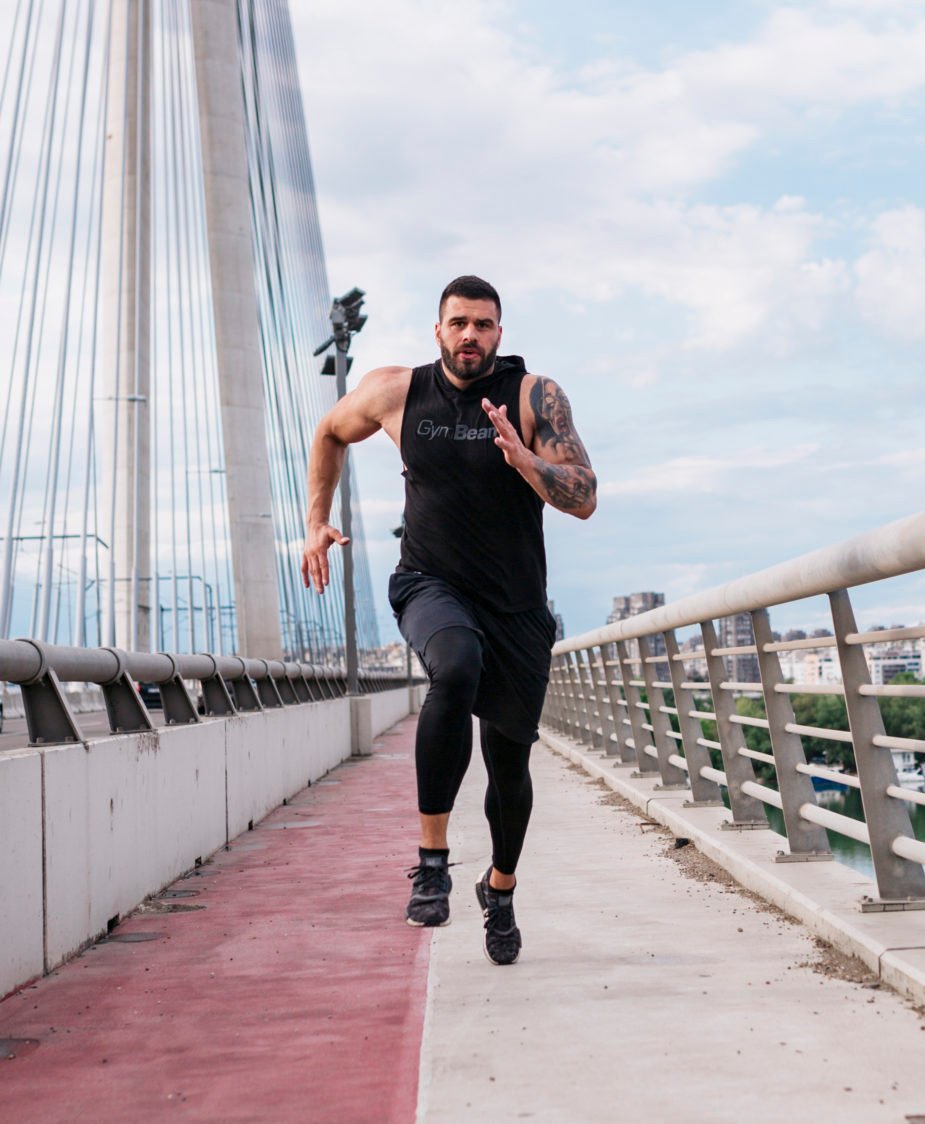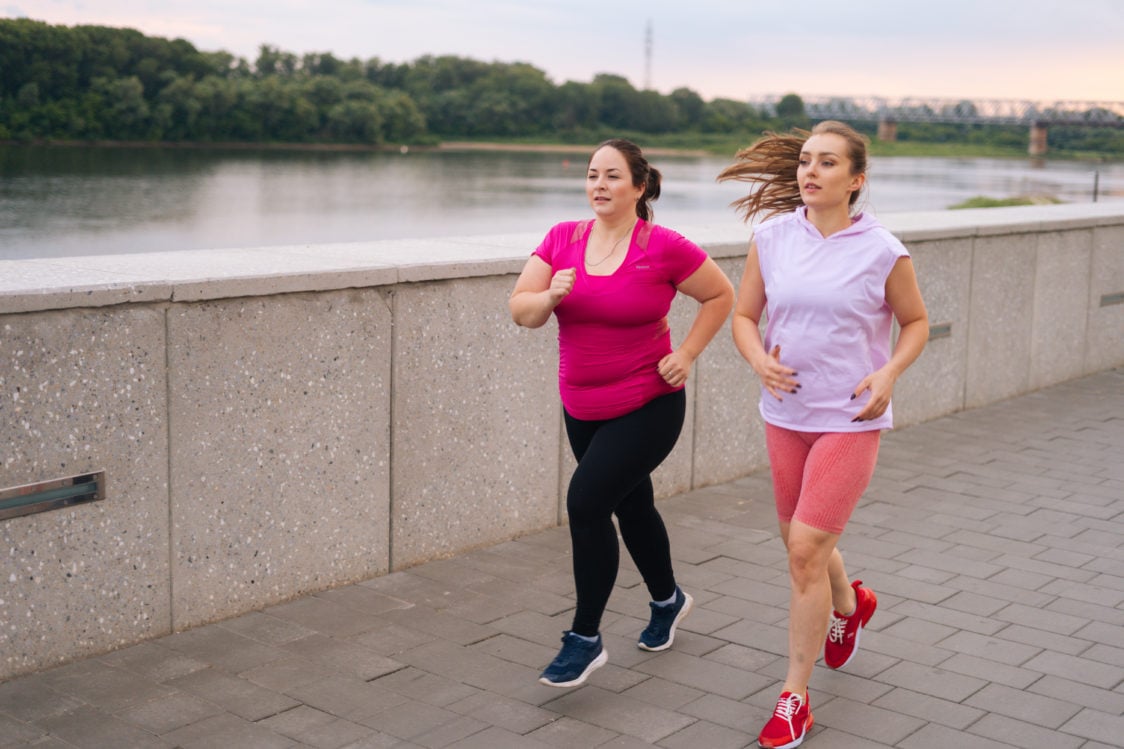Table of Contents
Running belongs among the most popular of sporting activities. It can be enjoyed almost anywhere, it is suitable for beginners and advanced athletes, and it has numerous proven benefits for your body. Even so, it is often thought to be harmful to your joints. This is what discourages many people from putting on running shoes, who prefer to stick to walking or save their joints by relaxing on the couch. Are they doing the right thing, or are they unnecessarily depriving themselves of a great running experience and the benefits of running?
Is running actually healthy?
There is no need to doubt that movement is generally beneficial for our body. Let evolution be proof, we are simply born to move, including running.
Running has a positive effect on:
- cardiovascular health
- the psyche
- hardness and resistance of bones (mineralisation)
- optimal weight control [1]
How is it with running and your joints?
What about the knees, hips and actually the whole musculoskeletal system? Do you really have to pay the price for running with damaged cartilage?
A number of studies have been conducted on this topic, most of which have reached positive conclusions. Some even suggest the exact opposite, that running promotes joint health. These encouraging results have been seen particularly in papers that have focused on recreational athletes. Compared to professional runners, they generally put their joints under less stress, which may be more optimal for the body.
But you have to look at all this in a broader perspective. Many other factors influence the condition of the joints. These are mainly genetics, body weight and also the overall strain on the musculoskeletal system, which includes, in particular, the nature of one’s employment and movement. And with the latter, the less, the better in the sense of saving your knees and hips for old age. Quite the opposite. It seems that if movement is done correctly and at a reasonable rate, your joints do benefit from it.
Of course, if a person is seriously overweight or obese, it will be better to start with fast walking with hiking poles. It will be safer to switch to running after the joints have adapted to the load and ideally after losing a few kilos.
Wondering what benefits running can bring to your body? Then read our article 11 Reasons to Start Running. How Will It Change Your Body?

The effect of sporting activities on joints
- Thanks to adaptive mechanisms that occur when joints are regularly loaded, their function and range of motion improve. [2-3]
- The joints become more lubricated with synovial fluid due to movement, which helps to provide nutrition for the cartilage. [11]
- At the same time, the waste substances produced by cartilage metabolism are washed away more efficiently. [11]
- Through sport, you strengthen the muscles, ligaments and other body structures that surround the joint and provide it with functional support. This can result in, for example, an improved and more stable posture. [2-3]
Despite the benefits of exercise on your joints, many people claim that running is an excessive strain on their joints, which is unhealthy. They believe that the main risk is wear and tear on the cartilage, which has to cushion the hard impacts, especially on asphalt or other hard surfaces. This is why running is often classified as a high-impact activity.
But this does not mean that it is harmful for your joints. Cartilage can adapt to high loads, and if you don’t run a marathon straight off from the couch and instead follow the path of gradually increasing training volume, running shouldn’t damage them. This is of course is true for people who start their running career with relatively healthy joints and pay proper attention to joint care, nutrition and recovery.
Current thinking seems to be that joints function similarly to muscles in this regard, and if you don’t use them and give them enough of a boost, their functionality can gradually deteriorate. So the old “Use it or Lose it” applies here too. [4]
If you’re wondering which dietary supplements can help you boost your running or other aerobic performance, check out our article 11 Top Dietary Supplements for Running, Cycling, and Other Endurance Sports.
You might be interested in these products:
What do studies prove about the effect of running on joints?
When examining the effects of running on joint health, researchers most often evaluate the risk of developing osteoarthritis (OA). This disease is one of the biggest culprits affecting your joints. It causes a loss of cartilage mass, which then cannot reduce the shock and friction of the bones in the joint as well as it should. This results in pain, swelling in the joint area and limited mobility. In the worst stage (stage 4 OA), surgery is required in the form of a total joint replacement, most commonly of the knee or hip. [5]
The prolonged joint loading that occurs during running could mean a higher risk of developing OA. However, even long-term studies have failed to confirm this association with runners. They have actually been observed to have a lower incidence of the disease compared to non-runners. A difference was also observed between recreational runners and professionals, with OA symptoms appearing less frequently in amateurs. [6-7]
Does running destroy cartilage?
According to a meta-analysis that evaluated the results of 43 studies, there was a reduction in cartilage volume immediately after running. However, it appears that this change is not permanent. In fact, the distribution and amount of fluid in the joint changes dynamically during movement. However, this is a transient condition. In fact, the results of this show that cartilage has a good ability to recover after training and can thus adapt effectively to repeated loading. Another interesting finding was that people with milder cartilage damage due to running did not experience joint deterioration. [4]
Evidence of the adaptive capacity of cartilage is also provided by another study. In it, researchers observed an increase in the amount of glycosaminoglycan (GAG), which is an important structural component of cartilage. In fact, it is related to its quality. Compared to the control (sedentary) group, the novice runners had higher levels of this substance after 10 weeks of training (running 3 times a week, gradually increasing the load). Thus, this is a positive response of cartilage to a training load. [8]
In addition to regular exercise and nutrition, overall care for the health of the musculoskeletal system is also important for joint health. You can read about nutrition for joints in our article How to Choose the Best Joint Supplement?

Is running or walking better for your joints?
People who are worried about their joints often prefer walking to running. Walking or hiking may not appear to put as much strain on the musculoskeletal system as running. However, as you know, appearances are often deceiving and even in this case all is not so black and white.
When researchers looked at the effect of running and walking on cartilage, they found that ultimately these activities have a similar effect. While running did result in more intense contact between the different parts of the joints, the overall stress on the joints was comparable to the effect of walking. [1, 6]
This is probably due to the fact that when running the cartilage has to cushion the harder bone contacts, but on the other hand these contacts last a shorter time than when walking.
This is due to the shorter contact time of the foot with the ground. The number of steps over the same distance, which you take less of when running than when walking, probably plays a role as well.
It turns out that the total load on joints, which is crucial for the development of osteoarthritis, is relatively low with running. [1, 6]
Another interesting fact is that it may be more beneficial for your knees and hips to run faster. The reason is again the number of steps. When you run the same distance faster, you take fewer steps than at a slower pace. The result, in turn, will be less strain on the musculoskeletal system overall. [9]
Are you one of those people who have been planning to start running regularly for a long time but lack motivation? If so, the practical advice in our article may be helpful – 10 Effective Tips to Motivate Yourself to Run When You Don’t Feel Like It.
Is it advisable to run with excess weight?
Having just learned that running is actually not the biggest enemy of joints, the question arises whether it is harmless even for people with a higher body weight. They are traditionally advised to opt for swimming, cycling, Nordic Walking and other activities that are considered safer for the musculoskeletal system. In this case, things might be a little different again.
This is according to a study that looked at normal weight, overweight and obese runners. In it, experts concluded that normal weight runners were more likely to have knee injuries compared to those with a higher body weight. However, it is important to note in this regard that people with a lower weight may have run longer distances and trained more frequently, increasing the likelihood of injury. [10]
Excess weight itself has a negative effect on joints. But it is not necessary to limit yourself to walking and swimming to reduce weight. Running can also be an effective tool for burning calories and improving body composition in overweight and obese people. However, in their case, it is especially true that they should start slowly and increase the load gradually. They can start their physical activity with brisk walking with poles, then progress to walking without poles and eventually to running. This will give their joints the opportunity to gradually adapt to the load. If all goes well, and they lose weight, they will eventually get to a lower weight that will be a little more favourable for their knees and hips. In fact, running for several years with excessive weight can be risky in terms of developing OA.
In case you want to lose a few kilos and don’t know quite how to do it, you can find practical tips in our article How to Lose Weight Quickly Without Counting Calories.

How to reduce the risk of joint pain from running?
For all runners, not only beginners, you should invest in quality cushioning shoes, as well as functional running attire, choose softer terrain (forest and dirt roads) and ideally get advice from an experienced coach at the beginning. This can help you with the correct running technique. At the same time, it is also worth remembering strength training. Regular leg strengthening leads to the strengthening of the muscles and other supporting tissues surrounding the joints.
In case your joints still hurt after running, the cause may not be the running itself. It might be due to overuse, insufficient rest, inappropriate footwear or poor running technique. However, these problems can be solved and it is not immediately necessary to put running on the list of activities that are forbidden for you. Instead, seek out a running coach, sports doctor or physiotherapist who has experience with runners and can help you improve in all aspects of running so that your joints don’t hurt.
Seven essential tips for healthy running
1. Maintain a healthy weight
Being overweight is not optimal for your joints. It puts extra strain on them, which they have to cushion. If a person has some extra kilos, it is better to focus on losing them gradually. A combination of healthy diet, cardio and strength training works best for this. [12-13]
2. Choose high quality running shoes
First and foremost, you should always feel comfortable in your running shoes. However, the type of surface on which you most often run (asphalt, forest tracks, trail) also plays an important role in your choice. Specialist running shops can also do a gait analysis to see if you have a tendency to pronation (inwards) or supination (outwards). [12-13]
3. Focus on proper running technique
A running coach can advise you on this, or at least search the internet for videos on proper technique to see how to do it. The advantage of a coach is that they can correct your technique right away and will probably even notice details that you don’t notice yourself. Also, you can get someone to record a video of you running, which you can then use to see if you’re making any major errors.

4. Choose a route with a softer surface for running
If you have a forest or dirt roads nearby, ideally go there for your run. These surfaces are better for the joints because they don’t require as much cushioning as they do on asphalt. [12-13]
5. Do a light warm-up before you run
Just move around and stretch the joints of the whole body for a few minutes. Those who are really serious about running can add a few exercises from the running alphabet. If you’re wondering what else to look out for before a run, check out our article What Not to Do Before a Run? 10 Mistakes Every Runner Has Encountered.
6. Increase your load gradually and don’t forget to rest
If you’re starting out, gradually add kilometres and time spent training. This will help you avoid overtraining, which could put you out of the game for a long time. Additionally, for most amateur runners, it is not advisable to run every day. This is because your joints need plenty of rest to enable them to recover and prepare for the next run. [12-13]
7. Supplement your running with strength training
On non-running days, include bodyweight training, or dumbbells and kettlebell exercises. Focus on the mid-body and lower limbs. This will strengthen the muscles surrounding your joints and, with a strong core, you can improve your coordination and stability. [12-13]
Based on these findings, running seems to be a suitable sporting activity for most people. However, you cannot forget that each of you has a different start position and your current health plays a big role. It also all depends on your current life situation and how running fits into it, because even though two people are both doing the same thing, it’s not the same thing.
- For more practical advice for first time runners, read How to Start Running? A Simple Guide for Beginners.
- To stay motivated and focused read our article Is Running Boring? We’ll Reveal How to Take a Liking to It and Continuously Keep Improving.
What should you remember?
After reading today’s article, you already know that running does not have such a negative effect on your joints. According to current evidence, this physical activity has a rather more positive effect. It even has a comparable impact on your joints as walking. Unless you have a musculoskeletal disorder, there is no reason to worry about the harmful effect of running in this respect. Moreover, regular joint loading can have a beneficial effect on the nutrition and functioning of cartilage.
However, all runners, especially in the beginning, should increase the training load gradually and not forget to rest. This is the only way to give joints the opportunity to regenerate adequately and adapt more easily to physical activity.
If you liked this article and have someone in your inner circle who thinks running is bad for their joints, please share this article with them. Maybe you can help change their mind about running.
[1] Physiopedia. Runners and Knee Osteoarthritis.– https://www.physio-pedia.com/Runners_and_Knee_Osteoarthritis
[2] Petrigna, L., Roggio, F., Trovato, B., Zanghì, M., Guglielmino, C., & Musumeci, G. How Physical Activity Affects Knee Cartilage and a Standard Intervention Procedure for an Exercise Program: A Systematic Review. – https://doi.org/10.3390/healthcare10101821
[3] Smith, A. How Your Joints Benefit From Exercise. – http://blog.arthritis.org/living-with-arthritis/exercise-benefits-for-joints/
[4] Khan, M. C. M., O’Donovan, J., Charlton, J. M., Roy, J.-S., Hunt, M. A., & Esculier, J.-F. The Influence of Running on Lower Limb Cartilage: A Systematic Review and Meta-analysis. – https://doi.org/10.1007/s40279-021-01533-7
[5] Osteoarthritis. Arthritis Foundation. – https://www.arthritis.org/diseases/osteoarthritis
[6] Miller, R. H., Edwards, W. B., Brandon, S. C. E., Morton, A. M., & Deluzio, K. J. Why don’t most runners get knee osteoarthritis? – https://doi.org/10.1249/MSS.0000000000000135
[7] Alentorn-Geli, E., Samuelsson, K., Musahl, V., Green, C. L., Bhandari, M., & Karlsson, J. The Association of Recreational and Competitive Running With Hip and Knee Osteoarthritis: A Systematic Review and Meta-analysis. – https://doi.org/10.2519/jospt.2017.7137
[8] Ginckel, A. V., Baelde, N., Almqvist, K. F., Roosen, P., McNair, P., & Witvrouw, E. Functional adaptation of knee cartilage in asymptomatic female novice runners compared to sedentary controls. – https://doi.org/10.1016/j.joca.2010.10.007
[9] Petersen, J., Sørensen, H., & Nielsen, R. Ø. Cumulative loads increase at the knee joint with slow-speed running compared to faster running: A biomechanical study. – https://doi.org/10.2519/jospt.2015.5469
[10] Juhler, C., Andersen, K. B., Nielsen, R. O., & Bertelsen, M. L. Knee Injuries in Normal-Weight, Overweight, and Obese Runners: Does Body Mass Index Matter? – https://doi.org/10.2519/jospt.2020.9233
[11] Dong, X., Li, C., Liu, J., Huang, P., Jiang, G., Zhang, M., Zhang, W., & Zhang, X. The effect of running on knee joint cartilage: A systematic review and meta-analysis. – https://doi.org/10.1016/j.ptsp.2020.11.030
[12] Is running bad for your knees? – https://patient.info/news-and-features/is-running-bad-for-your-knees
[13] The truth about running and joint stress. – https://www.piedmont.org/living-better/the-truth-about-running-and-joint-stress

